
Made from two simple beams and two sawhorses, Josh's Finn's simple, storable workbench is remarkably versatile. Here he's got the beams set up side by side with a stop screwed on for handplaning. Download the free plan to make the sawhorses.
Fine Woodworking is no slave to tradition, and we’ll take great ideas wherever we can get them. You should too.
In her travels in upstate New York, FWW editor Anissa Kapsales ran across a pro woodworker with a workbench unlike anything we’ve seen. Josh Finn’s innovative bench, featured in 2008’s Tools & Shops issue (FWW #202), is nothing more than two long boxes and two sawhorses, but it can do everything the fanciest Scandinavian bench can do, and more. It can be configured in a variety of ways for all sorts of power and hand work, plus gluing and clamping. Try that with your dad’s workbench.
| UPDATE: Download the FREE PLAN to make these sawhorses. |
One side of the long beams is melamine, which resists glue, and the other is Homasote, a soft fiberboard that grips workpieces, won’t mar them, and is easy to replace when it becomes riddled with holes, gauges, and sawkerfs. And the whole thing can be broken down easily and stored. Also, if you remove the long beams, the two broad-topped horses come in handy as a low assembly table and more.
I’d say this bench is is more suited to power-tool lovers than the hand-tools-only crowd, but if you need a versatile workbench and have at least rudimentary skills and tools, you should give this innovative workstation serious thought.
| More workbench projects on FineWoodworking.com • FW’s Guide to Workbenches • Garrett Hack’s New Workbench • FREE PLAN: Easy Workbench • The Essential Workbench • Matt’s Monster Workbench • New-Fangled Workbench • FREE PLAN: Rock-Solid Plywood Bench |

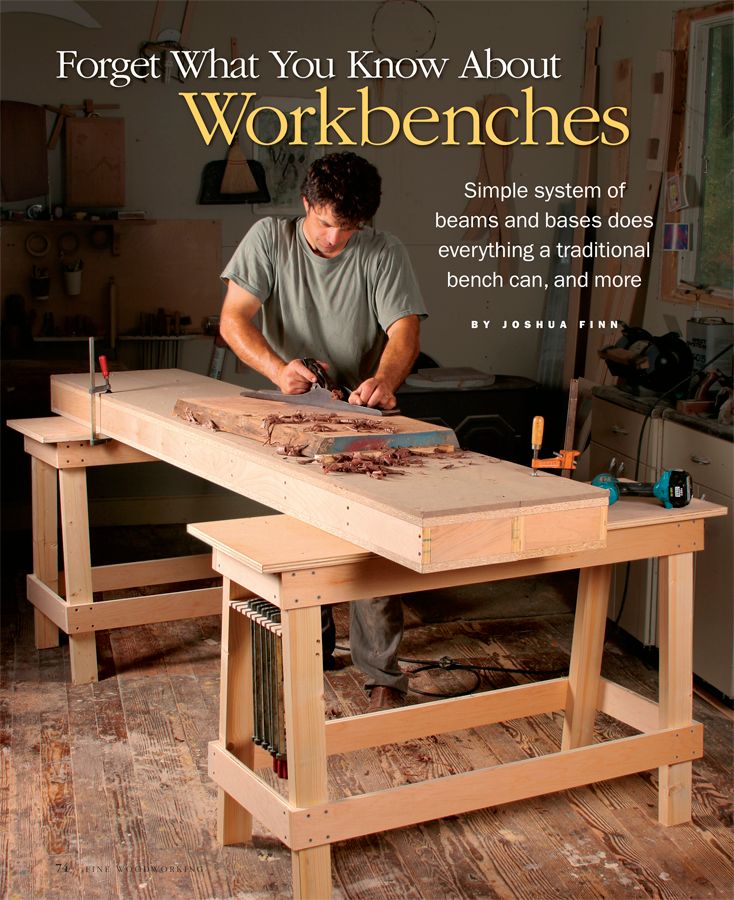
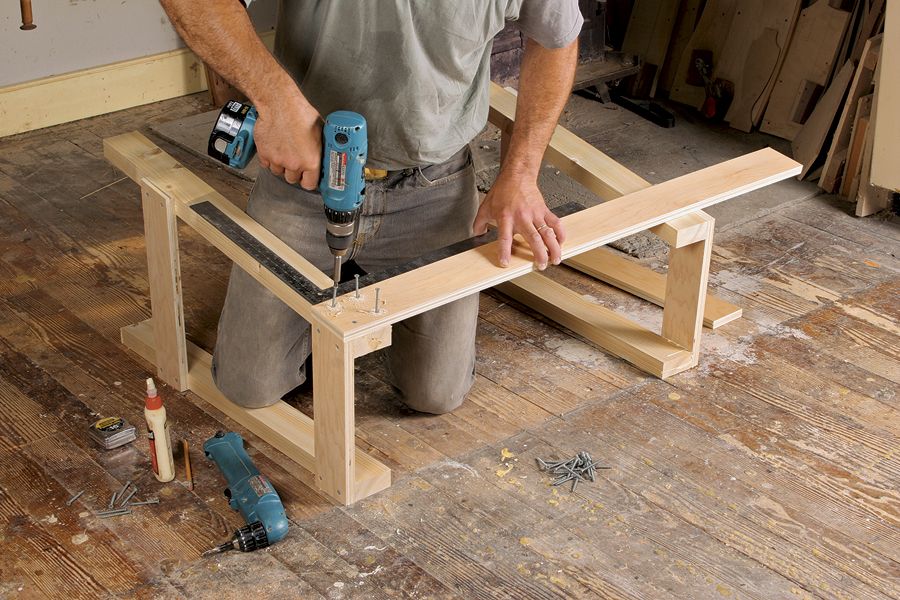
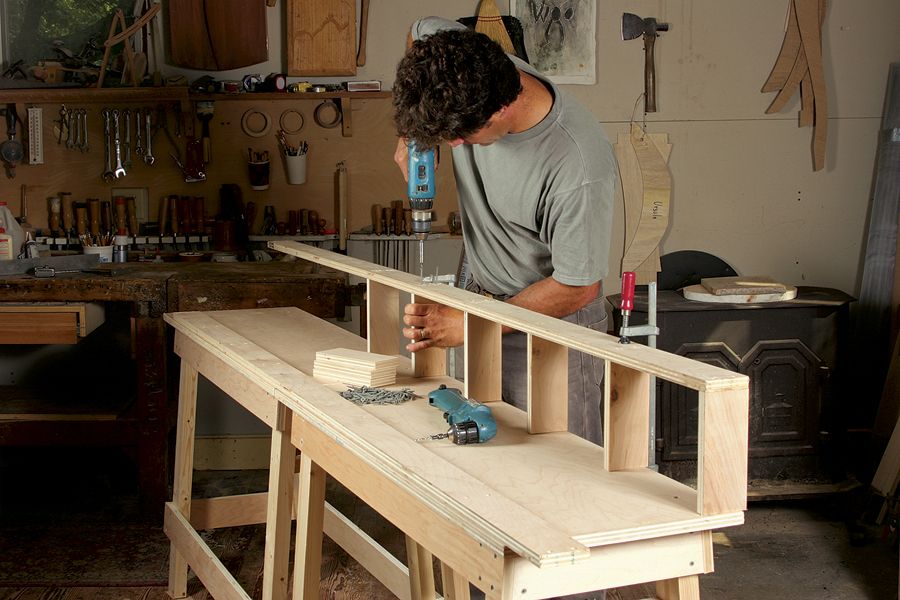
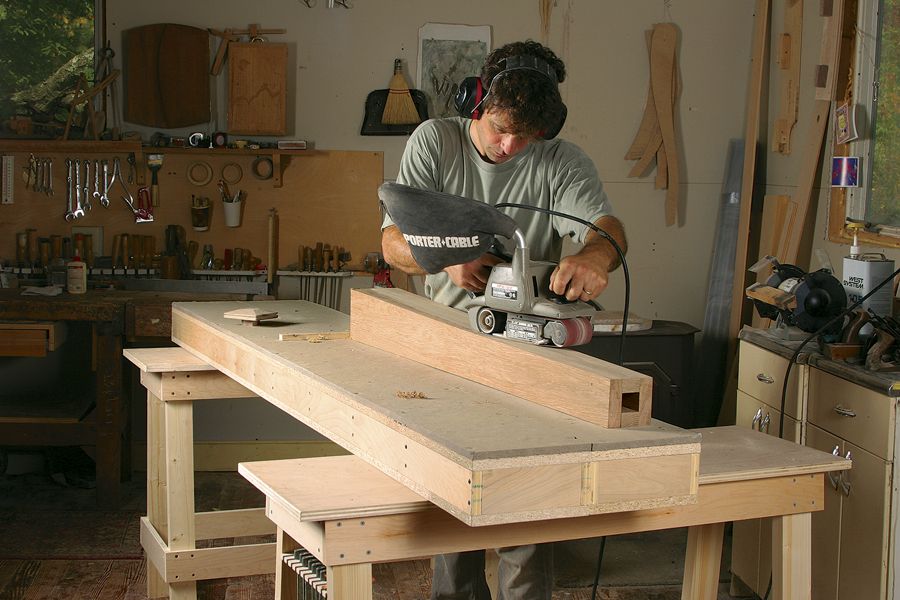
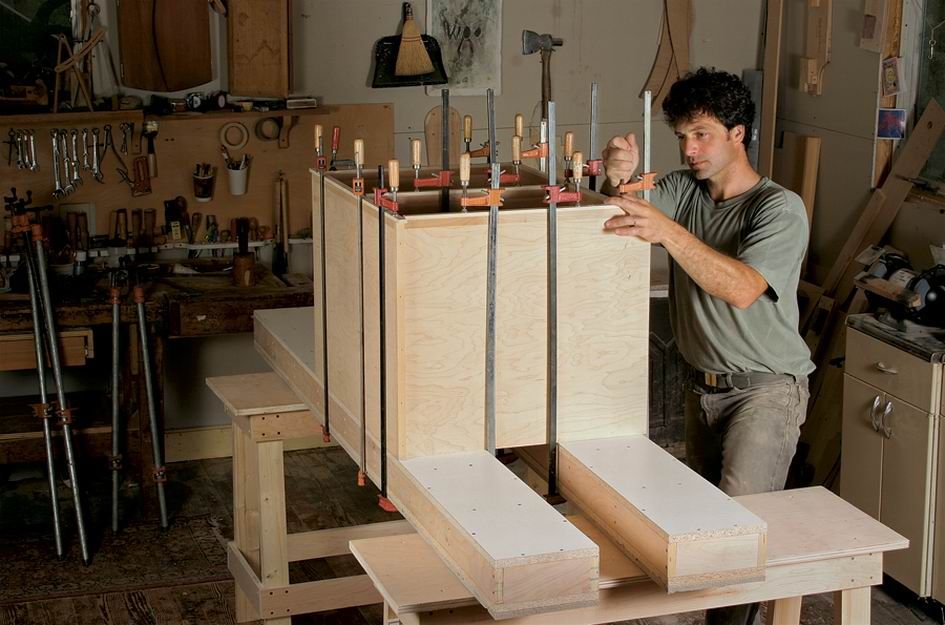





















Comments
Motivated by the article in Tools and Shops, I made this workbench after contemplating several different styles and designs. It was easy to build, economical (a plus in this recession) and it has been very flexible.
I still wish I had one of those traditional benches though.
Jeff... you should post pix of your "bench" here: https://www.finewoodworking.com/gallery
What design are you considering for your next bench? It's never too early to start planning for an upgrade. :)
I also made this bench and love it for its versatility. There are issues that come up from time to time but they are usually handled after rethinking the problem. I did drill holes through the beam's sides so that I could install pipe clamps to create a side vise of varying lengths (stole the idea from John White's newfangled bench) and this works well for speed when sawing dovetails and other such joints. For the cost conscious it is a very good and stable bench. My only issue is that I have not been able to find anyone who carries homesote. This has been very frustrating so it is just plywood on the one surface and melamine on the other of the beams.
Holden, you can go to the website below, and plug in your zip code to see where the suppliers of Homasote are in your area.
The FW article specifies Homasote 440. I noticed a couple of places in my area that sell the 440 per the search. Two others said they would special order. Since Homasote is typically for commercial use some of the sellers may not sell single sheets.
http://www.homasote.com/WhereToBuy/
Holden, you might try Menards for homosote, but I don't know the particular number for it.
Because of an untimely move, my "stationary" workbench is in storage. I needed to do some renovation work at my new locale and traditional saw horses just wouldn't have been sufficient. I built the two benches from Joshua's article while working on my driveway (in 20 degree weather), carried them inside (light and easy to navigate up a narrow stairway), and was able to do everything I had to do (with the addition of a couple of clamps.) The use of "cull" lumber from my local big box store kept the total cost under $25.
There are so many options for workbench tops and Homasote is only one of them. I would recommend to anyone considering this bench setup NOT to feel that without Homasote this won't work. Use your imagination! Hardboard, cork, a yoga mat, vinyl, laminate, carpet padding, carpet--whatever suits your need. Hard, soft, resilient, nonstick, nonscratch, waterproof, etc. Homasote is nice because is fulfills many of these needs, but it's not the only answer. I stuck with plywood and used a moving blanket when I needed to protect a finish.
Once my tablesaw comes out of storage I'll consider building the beams. I could've had the lumber yard rip a plywood or melamine sheet for me, but I didn't want to spend the money since I already had material (also in storage).
Great project with a million uses. Thanks!
Having worked with Homasote I think a good substitute would be suspended ceiling panels.
I built this bench when it first showed up in Fine Woodworking.
There are many positives to it, but one big negative for me.
I'm 74 and find that the two boxes are extremely heavy to the point that I just don't move it or change its configuration.
If the article mentioned that, I might just have built it with shorter boxes to make it more manageable.
In addition, my shop has seven foot ceilings so that with eight foot boxes, I can't stand them up for storage.
Gordon
I have a suggestion for the sawhorses. The long stringers (the ones about 8" above the floor) are positioned to bang up my ankles, and keep you from getting as close as possible to the work surface. My suggestion is to move those stretchers to the inside of the legs. This gives a couple of inches more clearance for your ankles, is almost as easy to build, and shouldn't sacrifice any strength.
I have always wanted to build one of the fancy sturdy work benches we see in all the publications. When I saw this simple one with obvious advantages, I build it right away. With the use of clamps and templates it has performed beyond my expectations. It is extremely versatile and has suited all my projects. I spend the bulk of my shop time at the bench. A eight inch bench vice was easily installed at the end of one of the boxes. Using pipe clamps and drilling holes through the side of one of the boxes a two ft long bench vice was fabricated. If the surface gets messed up, just change it. It also works great as an out feed table, and clamp holder. Now I have no desire to waste my shop time building that fancy bench. Once again the simplest solution is the best, but it takes a clever mind to see the simplicity. Thank you Mr. Finn.
Problem : my shop's floor isn't flat
After a test with a beam (built for a canoe), i am interested and convinced by the finn's bench but the flatness is necessary for a good use no ? an idea ?
thanks
I have the hard copy of this issue and really like the modularity for a small shop. But I got to thinking the Double I Beam style would be just as strong and give you a decent mounting clamping lip and have the upper surface clear. Insert the end blocks a good distance and make a pin nailed together hollow MDF slip tendon to join the I beams end to end. Same amount of material.
I made a modified version of this bench about 6 months ago. I’m very pleased with it. It’s offers all the advantages mentioned in Joshua Finn‘s article and many more. I’m setting up a workshop after selling and giving away my big tools rather than moving them 1400 miles. The workbench was the first thing I made. I cut all of the pieces using only a cordless jigsaw and Japanese saws. I mostly use hand tools at the bench.
The modifications: an 18” wide top, a shelf across the stretchers, clamp racks at both ends of the horses, 6’ torsion boxes using 10” melamine shelves and the scored side of 1/8” Masonite rather than Homasote, a 2” strip of plywood around the underside of the tops.
Using the modified design I’ve made a potting table, a drill press stand and a bandsaw stand. Next up is a router table stand.
My sincere compliments. Thanks, Joshua.
Brilliant! It's an extremely rare occurrence for me to comment on anything online. I downsized my shop. Built mine with 1/2" ply for the tops and bottoms of the torsion boxes. Set up in the garage. I get a truckload of plywood and slide it right off onto the Homasote tops and use a track saw to cut cabinet parts which I then carry through the house to my shop. I liken this setup to rigging a large sailboat with gadgets that make it easy to single hand. I can move a sheet of 3/4" plywood from the truck to the bench with one hand. No back strain! It is truly effortless. You won't believe how much use this gets for every project you can dream up. Did I mention how strong and lightweight? Well done Josh!
Log in or create an account to post a comment.
Sign up Log in